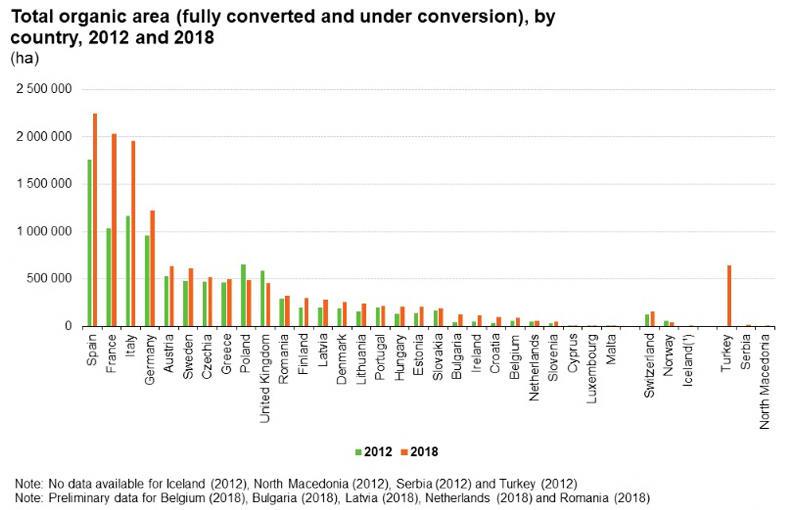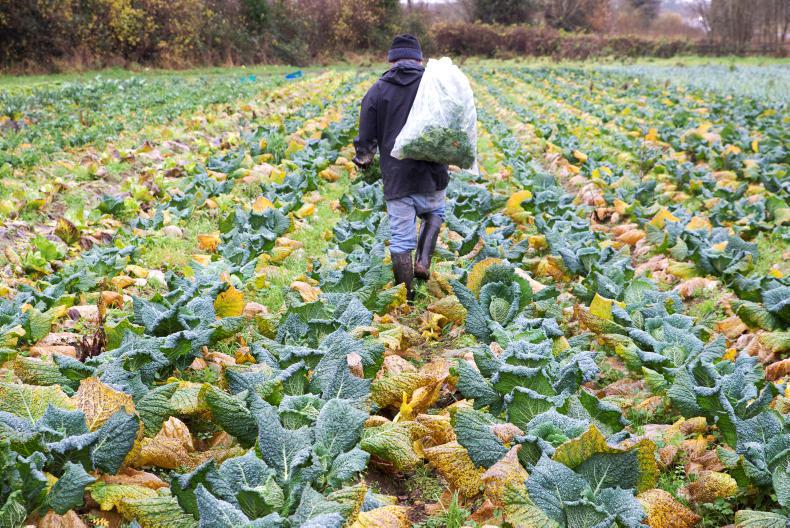Organic farming is set for a boost under the next Common Agricultural Policy (CAP), with plans to push organic land use in Europe from 7.5% to 25% by 2030.
The move is seen as key to the recently published Farm to Fork strategy, which emphasises higher animal welfare standards and lower pesticide use.
While the amount of farmland under organic production in Ireland more than doubled between 2012 and 2018, reaching 284,877ac, it still only makes up just over 2% of overall land use.
The Department paid €8.4m to 1,494 organic farmers last year
Just 2.6% of Ireland’s land area is being used for organic production in comparison to almost 25% in Austria and 20% in Estonia.
Despite the hurdle of a two-year conversion period and additional red tape, a cohort of Irish farmers seem keen to switch to organic.
Last year the Department of Agriculture received a deluge of applications when it reopened the Organic Farming Scheme.
However, with fears of an over-supply of organic beef, eligible applications were weighted in favour of tillage and dairy operations and just 55 out of 225 applications were accepted.
Farmers have insisted that the next scheme framework must be developed hand in hand with organic farmers
Overall, the Department paid €8.4m to 1,494 organic farmers last year but there have been ongoing complaints of tardy organic payments and schemes not fit for organic purposes.
Farmers have insisted that the next scheme framework must be developed hand in hand with organic farmers.
Many will also be keeping a close eye on “super junior” minister at the Department, Pippa Hackett, an organic farmer herself, and the role she will play in supporting the sector.
The future of organics: what’s needed?
Gillian Westbrook CEO, Irish Organic
Association

Pictured at the Irish Organic Association Field Talk Programme on the farm of Mark Harold Barry, Cordangan, Co Tipperary, are Gillian Westbrook, CEO, Irish Organic Association.
“We need a really strong action plan, the organic market is growing and we need a plan that balances supply and demand.
“We won’t be able to get away with some kind of ‘organic light’ offering.
“An export country like Ireland needs to take this seriously – demand for organic is growing and it sits with our image. The funding for marketing abroad also needs to be pushed. Organic is not a threat to this country, it’s an opportunity.
“Between 65% and 70% of organic cattle slaughtered are graded at R3. Over 45% of organic meat sold in Ireland is sold through the major discounters which de-busts the myth that only a certain kind of consumer buys organic.
“There’s a recent market that has just opened up for the Philippines and there is another processor looking for organic Angus cattle. He cannot keep up with demand.
“The catering sector abroad is looking for specific breeds, like organic Hereford or organic Angus. We need to start producing for a market rather than for a commodity.
“We’re not concerned with an influx of organic farmers because the European Commission has already highlighted in previous communications that they’ve evaluated market demand.”
Nigel Renaghan,
IFA organic chair

Poultry farmer Nigel Renehan on his poultry farm in Monaghan.
“The EU aspiration of 25% organic by 2030 doesn’t work in Ireland as we only have 2% now. Strong demand exists in the areas of cereals, dairy and horticulture but I would have concerns around beef.
“Bord Bia needs to recognise the organic standard. Origin Green is really good for Irish food but it needs to better express the differences in the standards.
“Teagasc also needs to have more research and promotion of the organic option, highlighting the benefits and yields of multi-species swards, red clover and combi-crops grown with no chemical fertiliser or spray.

Total organic area.
“Teagasc needs to do more trials on zero N grassland production and young farmers need more exposure to organic farming in agriculture colleges.
“A producer group for organic beef farmers could be very successful but it needs to be kept in mind that ABP has a share in the two main processors of organic meat, Slaney and Goodherdsman.
“Finally, the Department of Agriculture has a strategy group and has published a document but there hasn’t been much action. This group could have a meeting to see where it’s going with the aim of providing results.”
James Flahavan,
manager, Flahavan’s

James Flahavan (far left), manager at Flahavan's porridge.
“At the moment, we use about 7,000t of organic oats and over 4,000t of that comes from Irish suppliers. It’s been creeping up over the years.
“We’ve run a number of workshops to encourage more farmers into organics with Teagasc and organic certifying bodies. We’ve run a couple of different aspects to encourage organic beef or sheep into oats.
“Last year was the first year we had close to 100 organic suppliers, which was up from 50 or 60, but we can always do more.
“The yields will be down compared to conventional oats but the inputs will be lower as well. The guys in organics will be looking at it from an organic rotation point of view.
“They might sow something like red clover at other times of year.
“We’re probably experiencing more demand for organic oats outside of Ireland – we’re the number one brand of organic oats in the UK market.”
Farmer reaction
Paul Brophy, tillage farmer,
Co Kildare

Paul Brophy.
“We’re going to get 100ac converted into organic and we’re currently growing 25ac of organic broccoli in a shared arrangement with an organic farmer.
“We’ve learnt stuff from the organic side of things that we’ve converted into the conventional farming methods.
“The market is totally undersupplied and we can’t keep enough of what we’re growing supplied to the supermarket.
“We proved that we could do mainstream supermarket stuff and keep the organic side separate.
“We’re allowed to use organic fertiliser made out of seaweed. We use a garlic spray once a week to help keep pests away.”
John Fitzpatrick, suckler farmer,
Co Laois

John Fitzpatrick, organic suckler farmer, Co Laois.
“I’d love to see 25% of land become organic but my fear is the market won’t be there.
“Organic farmers are already leading the charge on biodiversity and the environment and that needs to be recognised.
“We’d like Bord Bia to do more marketing for us. Origin Green is promoting the conventional beef. What are they doing for organic produce?
“For the new REPS, being an organic farmer shouldn’t be a disadvantage.
“Being an organic farmer was a disadvantage in GLAS. There were 32 measures and almost half of those an organic farmer couldn’t take up because it would mean they’d be double funded.”
Cattle
Most – 1,400 – of Ireland’s organic farmers produce livestock. There are 15,000 cattle processed annually for organic beef. That’s 0.26% of total beef production in the country.
Tillage
There are 161 organic tillage farmers, with almost half of their 2,426ha under oats.
Sheep
Some 600 farmers keep sheep organically, producing 36,772 lambs annually – but as much as 72% of these are sold in conventional markets with no price premium.
Horticulture
Three hundred farmers produce organic fruit and vegetables on 524ha, but they can only meet 30% of the market demand in Ireland, meaning 70% of organic vegetables and fruit are imported.
Dairy
The Irish organic dairy sector is tiny, with just 45 farmers milking 2,912 cows and producing a minuscule 0.11% of total Irish milk production.
Read more
Farmer loses appeal over Organic Farming Scheme penalty
Incentives needed to drive organic farming in Ireland
Organic farming is set for a boost under the next Common Agricultural Policy (CAP), with plans to push organic land use in Europe from 7.5% to 25% by 2030.
The move is seen as key to the recently published Farm to Fork strategy, which emphasises higher animal welfare standards and lower pesticide use.
While the amount of farmland under organic production in Ireland more than doubled between 2012 and 2018, reaching 284,877ac, it still only makes up just over 2% of overall land use.
The Department paid €8.4m to 1,494 organic farmers last year
Just 2.6% of Ireland’s land area is being used for organic production in comparison to almost 25% in Austria and 20% in Estonia.
Despite the hurdle of a two-year conversion period and additional red tape, a cohort of Irish farmers seem keen to switch to organic.
Last year the Department of Agriculture received a deluge of applications when it reopened the Organic Farming Scheme.
However, with fears of an over-supply of organic beef, eligible applications were weighted in favour of tillage and dairy operations and just 55 out of 225 applications were accepted.
Farmers have insisted that the next scheme framework must be developed hand in hand with organic farmers
Overall, the Department paid €8.4m to 1,494 organic farmers last year but there have been ongoing complaints of tardy organic payments and schemes not fit for organic purposes.
Farmers have insisted that the next scheme framework must be developed hand in hand with organic farmers.
Many will also be keeping a close eye on “super junior” minister at the Department, Pippa Hackett, an organic farmer herself, and the role she will play in supporting the sector.
The future of organics: what’s needed?
Gillian Westbrook CEO, Irish Organic
Association

Pictured at the Irish Organic Association Field Talk Programme on the farm of Mark Harold Barry, Cordangan, Co Tipperary, are Gillian Westbrook, CEO, Irish Organic Association.
“We need a really strong action plan, the organic market is growing and we need a plan that balances supply and demand.
“We won’t be able to get away with some kind of ‘organic light’ offering.
“An export country like Ireland needs to take this seriously – demand for organic is growing and it sits with our image. The funding for marketing abroad also needs to be pushed. Organic is not a threat to this country, it’s an opportunity.
“Between 65% and 70% of organic cattle slaughtered are graded at R3. Over 45% of organic meat sold in Ireland is sold through the major discounters which de-busts the myth that only a certain kind of consumer buys organic.
“There’s a recent market that has just opened up for the Philippines and there is another processor looking for organic Angus cattle. He cannot keep up with demand.
“The catering sector abroad is looking for specific breeds, like organic Hereford or organic Angus. We need to start producing for a market rather than for a commodity.
“We’re not concerned with an influx of organic farmers because the European Commission has already highlighted in previous communications that they’ve evaluated market demand.”
Nigel Renaghan,
IFA organic chair

Poultry farmer Nigel Renehan on his poultry farm in Monaghan.
“The EU aspiration of 25% organic by 2030 doesn’t work in Ireland as we only have 2% now. Strong demand exists in the areas of cereals, dairy and horticulture but I would have concerns around beef.
“Bord Bia needs to recognise the organic standard. Origin Green is really good for Irish food but it needs to better express the differences in the standards.
“Teagasc also needs to have more research and promotion of the organic option, highlighting the benefits and yields of multi-species swards, red clover and combi-crops grown with no chemical fertiliser or spray.

Total organic area.
“Teagasc needs to do more trials on zero N grassland production and young farmers need more exposure to organic farming in agriculture colleges.
“A producer group for organic beef farmers could be very successful but it needs to be kept in mind that ABP has a share in the two main processors of organic meat, Slaney and Goodherdsman.
“Finally, the Department of Agriculture has a strategy group and has published a document but there hasn’t been much action. This group could have a meeting to see where it’s going with the aim of providing results.”
James Flahavan,
manager, Flahavan’s

James Flahavan (far left), manager at Flahavan's porridge.
“At the moment, we use about 7,000t of organic oats and over 4,000t of that comes from Irish suppliers. It’s been creeping up over the years.
“We’ve run a number of workshops to encourage more farmers into organics with Teagasc and organic certifying bodies. We’ve run a couple of different aspects to encourage organic beef or sheep into oats.
“Last year was the first year we had close to 100 organic suppliers, which was up from 50 or 60, but we can always do more.
“The yields will be down compared to conventional oats but the inputs will be lower as well. The guys in organics will be looking at it from an organic rotation point of view.
“They might sow something like red clover at other times of year.
“We’re probably experiencing more demand for organic oats outside of Ireland – we’re the number one brand of organic oats in the UK market.”
Farmer reaction
Paul Brophy, tillage farmer,
Co Kildare

Paul Brophy.
“We’re going to get 100ac converted into organic and we’re currently growing 25ac of organic broccoli in a shared arrangement with an organic farmer.
“We’ve learnt stuff from the organic side of things that we’ve converted into the conventional farming methods.
“The market is totally undersupplied and we can’t keep enough of what we’re growing supplied to the supermarket.
“We proved that we could do mainstream supermarket stuff and keep the organic side separate.
“We’re allowed to use organic fertiliser made out of seaweed. We use a garlic spray once a week to help keep pests away.”
John Fitzpatrick, suckler farmer,
Co Laois

John Fitzpatrick, organic suckler farmer, Co Laois.
“I’d love to see 25% of land become organic but my fear is the market won’t be there.
“Organic farmers are already leading the charge on biodiversity and the environment and that needs to be recognised.
“We’d like Bord Bia to do more marketing for us. Origin Green is promoting the conventional beef. What are they doing for organic produce?
“For the new REPS, being an organic farmer shouldn’t be a disadvantage.
“Being an organic farmer was a disadvantage in GLAS. There were 32 measures and almost half of those an organic farmer couldn’t take up because it would mean they’d be double funded.”
Cattle
Most – 1,400 – of Ireland’s organic farmers produce livestock. There are 15,000 cattle processed annually for organic beef. That’s 0.26% of total beef production in the country.
Tillage
There are 161 organic tillage farmers, with almost half of their 2,426ha under oats.
Sheep
Some 600 farmers keep sheep organically, producing 36,772 lambs annually – but as much as 72% of these are sold in conventional markets with no price premium.
Horticulture
Three hundred farmers produce organic fruit and vegetables on 524ha, but they can only meet 30% of the market demand in Ireland, meaning 70% of organic vegetables and fruit are imported.
Dairy
The Irish organic dairy sector is tiny, with just 45 farmers milking 2,912 cows and producing a minuscule 0.11% of total Irish milk production.
Read more
Farmer loses appeal over Organic Farming Scheme penalty
Incentives needed to drive organic farming in Ireland












 This is a subscriber-only article
This is a subscriber-only article










SHARING OPTIONS: